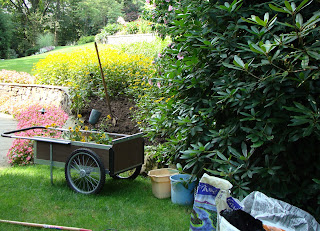Hellebores - The Enduring Mid-Winter Flower
one of my landscapes - Jan Johnsen
What is evergeen, deer resistant, thrives in shade, has flowers and comes back every year?
You could answer Andromeda (Pieris) - but it doesn't really like shade.
Perhaps you answered Hakonechloa (Japanese Forest Grass) but it doesn't have flowers.
Barberry (berberis) and Daffodils are not evergreen.
Grasses, Boxwood and sedges don't meet this criteria either....
The problem free, shade loving Hellebore (Helleborus) is the answer. They are a perfect plant for a Serenity Garden....
The Perennial Plant Association's Plant of the Year for 2005, Hellebores bloom from winter to early spring across the United States, depending on USDA zone and variety. They like light to moderate shade, especially an area shaded by deciduous trees, with full sun when they flower, and protection from summer heat.
Hellebores sport drooping, buttercup-like flowers colors of pink, mauve, white, green, burgundy, yellow, black-purple, bi-colored, speckled and more. These flowers last into the summer, becoming greener or darker with maturity. They make a spectacular cut flower and you can float the blooms in a shallow bowl.
HGC Winters Song
Helleborus are native to Eastern Europe and Asian and have been used in gardens for centuries. In Elizabethan times, hellebores planted near your door were believed to keep your home free of evil spirits and witches (maybe this is because every part of the plant is poisonous).
HGC Cinnamon Snow
Interestingly, hellebore flowers don't have petals but have colorful, cold hardy sepals. Sepals attract early season pollinators (honey bees, wasps) and protect the plant's reproductive parts. Unlike petals, sepals actively photosynthesize, which is why they stay intact and darken through the season.
In recent years Hellebores have been rediscovered.... At a time when most other things in the garden are bare and uninspiring, hellebores add a touch of brightness to a winter garden.
Their dark green, leathery clumps of evergreen foliage grow larger as the years pass and they look great in winter. They are hardy from Zone 5 - 9. Mulch well in colder climates and protect from shelter from drying, winter winds. Adequate moisture, particularly in spring, is essential. One plant can be 12" to 18" tall, 18" to 24" wide and container plants can be planted at almost any time.
The two most commonly seen species are known as Christmas Rose (H. niger) and Lenten Rose (H. orientalis), due to the time of year they flower and their rose-like blooms. But many are simply called hybridus, due to interbreeding.
Sunshine Farm Hellebores
HGC Joseph Lemper
An improved form of Helleborus niger comes from the German breeding program of Joseph Heuger. His HGC or 'Helleborus Gold Collection' has strong stems, upright, outward facing flowers (not droopy!) and a long flowering period. H. 'HGC Josef Lemper' has large white flowers which starts blooming in late Fall and continues until March. These flowers provide an amazing, midwinter flowering display. Plus all HGC hellebores bloom in their first year and are tissue cultured so every plant is vigorous.
HGC Joseph Lemper
Helleborus niger 'HGC Jacob' is Burgundy-stemmed with pure white flowers with a pink blush in cooler weather. The flowers are slightly fragrant, numerous and long-lasting. The foliage is deep green, toothed and held on dark stems. Blooms extremely early from November through January - a true Christmas rose. Can be brought inside to enjoy as a holiday decoration and then planted outside in the spring.
HGC Pink Frost
Helleborus x ballardiae 'HGC Pink Frost' features burgundy and white buds whch open to soft pink shades. Flowers mature to deep burgundy. As fresh blooms appear a multicolored effect is created with a legion of burgundy buds unfurling in antique-toned pinks. Serrated, rich green foliage with red stems are the best.
Blooms January–March. Size: 9"–15" high x 18" wide; hardy to zone 5.
Pine Knot Farms
Pine Knot Farms in Virginia is a premier Hellebore nursery.. Every Winter they have a Hellebore Festival. If you live nearby please check it out! with speakers, tours, etc.
Here is a great book on Hellebores:
Here is a great book on Hellebores:


















I've been fascinated by Hellebores for years but just couldn't bring myself to believe they'd grow in my zone just north of Houston. Guess I'm just going to have to give them a try. They're simply gorgeous!! Thanks for the great article!!
ReplyDeleteHellebores are one of my favorite perennials, and Pine Knot Farms and Sunshine Gardens are my favorite hellebore nurseries. I definitely favor the hybridus over orientalis, and although this is just a personal preference, they seem to grow in neater clumps and bloom later in the spring so the flowers last for months! Thanks for all that info on such a great plant!
ReplyDeleteThanks--another entry for next spring's wish list. The hellebore which I grow has nodding blooms--would welcome upright blooming plants.
ReplyDeleteThe upright flowers are the wonder...can't wait to see them...only a few more months...
ReplyDeleteSome very nice Helleborus you have! WE have a few of these special plants in our range in the UK. It is good to see they are appreciated. The Pink Frost we are trying for the first time this season, but from all the pictures I have seen it looks really nice. Chris - Gardening Express
ReplyDeleteI'm really enjoying the design and layout of your site. It's a very easy on the eyes which makes it much more pleasant for me to come here and visit more often. Did you hire out a designer to create your theme? Fantastic work! best marijuana online
ReplyDelete